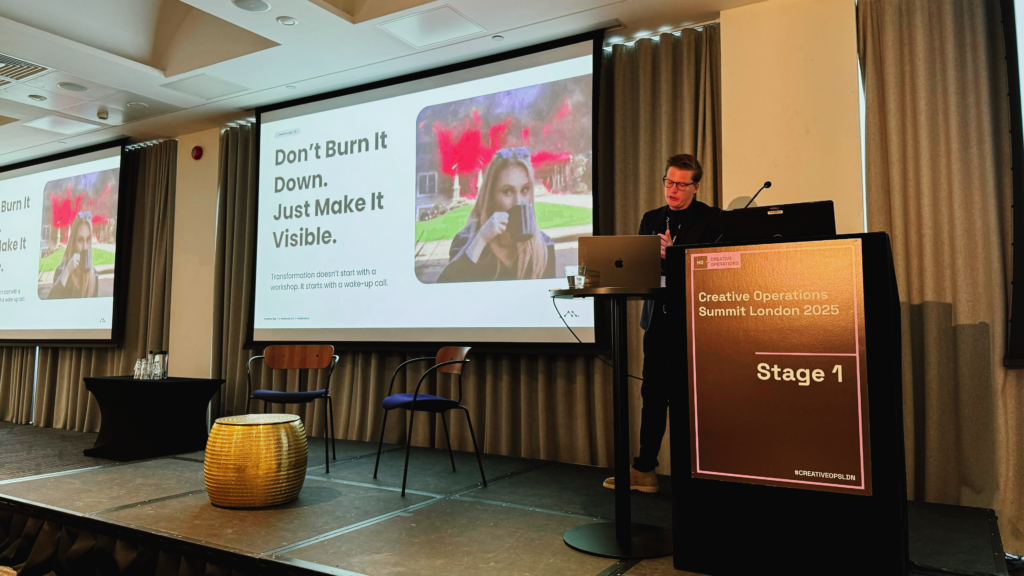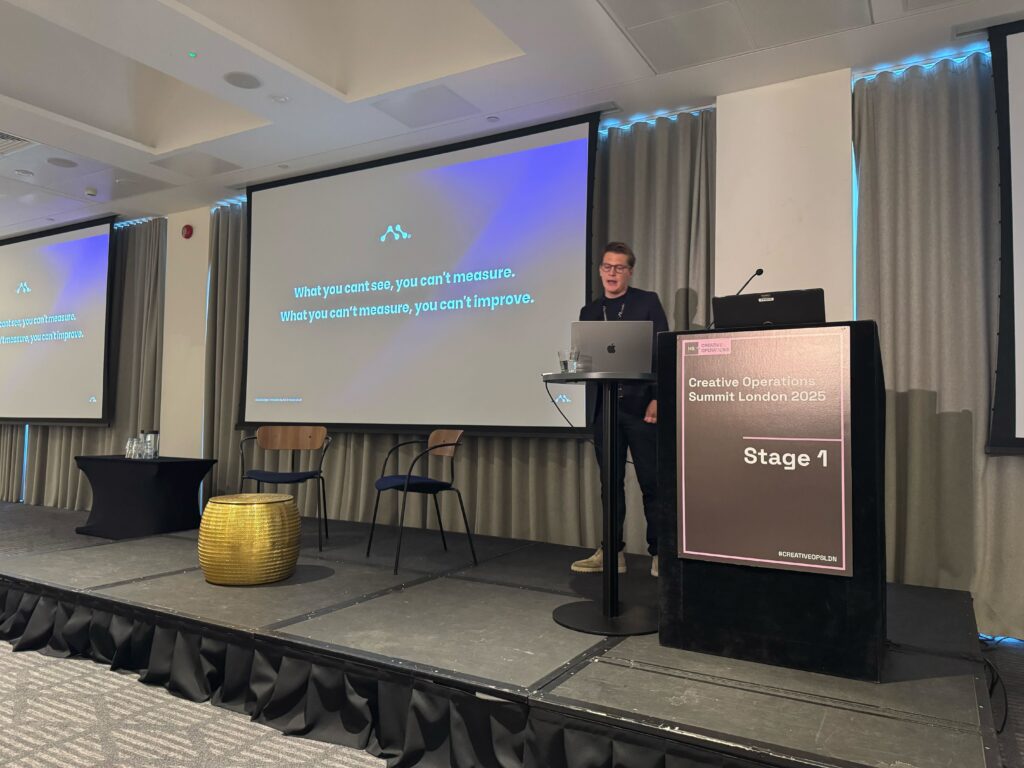“Don’t Burn the House Down”: Rethinking Visibility in Creative Operations – Highlights from Creative Ops 2025 London

State of the world
Last month, I had the pleasure of speaking at Creative Operations 2025 in London—a gathering of passionate ops leaders, brand builders, and creatives looking to navigate the ever-evolving operational landscape. My session focused on a message that resonated deeply with attendees: visibility shouldn’t come at the cost of disruption. You don’t need to burn the house down to build a smarter, more transparent creative operation.

Time Is Short
Marketing has always moved fast—but today, it’s blistering. It’s arguably the most disruptive, dynamic corner of any organization. Campaign windows are tighter, audience expectations are higher, and the tech stack changes faster than most teams can keep up with. And yet, we’re still asking people to pause and plan like time is a luxury.
The reality? It’s not.
Most marketing and creative teams are operating under relentless pressure to deliver—across more channels, with fewer resources, and in less time. In that environment, spending weeks scoping, strategising, and aligning becomes a blocker, not a benefit.
This is why visibility matters so much—not as a reporting layer, but as a way to keep moving without losing clarity.
Because when time is short, you can’t afford to spend hours hunting for information, second-guessing decisions, or waiting for a retrospective to tell you what went wrong.
In these conditions, we have to get sharper about questioning our assumptions.
- Do we really need another planning cycle, or do we need better signals today?
- Are we trying to optimise the process, or avoid making a call?
- Is complexity creeping in because of genuine need—or lack of visibility?
When people are under this kind of pressure, clarity is oxygen. That’s what visibility gives us—not a perfect system, but a way to keep going, faster and smarter.
The Visibility Myth
Many organizations think visibility in creative operations means sweeping change. Reorgs, process overhauls, new systems, and a dozen consultants later—only to find themselves in the same tangle, just with different job titles.
What I argued is simple: visibility is a capability, not a destination. And it’s something you can start building incrementally, today.
Start with Tech, Not After It
Too often, technology is brought in as the last step, expected to somehow make sense of a mess that wasn’t designed with visibility in mind. My belief (and Medialake’s founding principle) is that visibility should start with tech—not end with it.
By embedding lightweight, intuitive tools early—ones that don’t require ripping up current processes—we enable teams to see their workflows, creative pipelines, and performance metrics in real time. This leads to smarter decisions and faster iteration, without slowing anyone down.

Practical Steps, Not Moonshots
In the session, we explored how small, manageable actions beat big, abstract strategies. Visibility doesn’t require a “transformation initiative”—it just needs:
- Simple implementation that doesn’t take years to achieve
- A simple, clear view of your creative eco-system
- Data you can trust—and access without jumping through complex hoops
- Stakeholder alignment around what “good” looks like
These aren’t pipe dreams—they’re practical steps we’ve seen teams achieve in weeks, not months.
Real Talk About Complexity
Let’s be honest: creative operations can feel chaotic.
Campaigns move at breakneck speed. Briefs change mid-flight. Feedback loops multiply. Inputs come from everywhere—internal stakeholders, agencies, brand teams, media teams—all with different expectations, timelines, and vocabularies. And in the middle of it all? Creative ops teams trying to hold it together.
That’s not a failure of process—it’s the nature of the work. Creativity doesn’t follow a neat, linear path. But too often, in trying to tame that chaos, we over-engineer the solution. We pile on new tools, new frameworks, new layers of governance—until the very systems meant to help start to slow us down.
In the session, we flipped that thinking.
What if the goal isn’t to control the complexity, but to simplify the view?
Instead of fixing everything, we talked about the power of making just enough visible to take the right next step. That means:
- You don’t need to map every touchpoint—just the ones that consistently cause friction.
- You don’t need to report on everything—just what drives better decisions.
- You don’t need a perfect taxonomy—just one that your team actually understands.
Simplicity isn’t about doing less—it’s about doing only what matters.
When teams can see what’s happening, where the bottlenecks are, and what needs to happen next, they move with more confidence. And that clarity is what unlocks real momentum—not more complexity disguised as structure.
The best creative ops leaders aren’t building complicated systems.
They’re removing noise, reducing drag, and making space for work to flow.

Favourite Questions from the Room
One of the best parts of speaking at Creative Ops 2025 was the honest, no-fluff questions that came from the audience. Here are two that really stood out—:
1. “How do you know when you’ve got enough visibility?”
This one hit home. It’s easy to fall into the trap of chasing total visibility—every data point, every process detail, every metric. But in practice, that’s not only impossible—it’s distracting.
My answer?: You’ve got enough visibility when your team stops asking “Where is this?” and starts asking “What’s next?”
That shift—from searching to acting—is the signal that your system is working for you, not against you.
2. “How do you actually change team habits and processes?”
A classic ops challenge. And here’s the uncomfortable truth: you probably won’t.
Creative teams aren’t wired to follow rigid process. It’s not because they’re difficult—it’s because their job is to think differently, break norms, and challenge structure. That’s literally what they’re paid to do.
So instead of fighting it, solve for it.
Design tools, systems, and workflows that meet teams where they are, with minimal lift, minimal friction, and maximum value. If it feels heavy, it won’t stick. But if it quietly makes their life easier? That’s where real adoption happens.
What’s Next for Creative Ops?
The future of creative operations isn’t more complexity—it’s more clarity. And that clarity starts by making visibility a habit, not a hero project.
At Medialake, we’re helping brands shift from reactive workflows to proactive creative intelligence. If that sounds like something your team needs, we’d love to talk.
Gratitude and Conversations That Matter
Huge thanks to the team at Creative Ops 2025 and everyone who attended the session. It was energizing to be part of such an honest conversation about what’s actually working in our industry. If you missed it and want to chat, drop me a line—let’s keep the conversation going.




